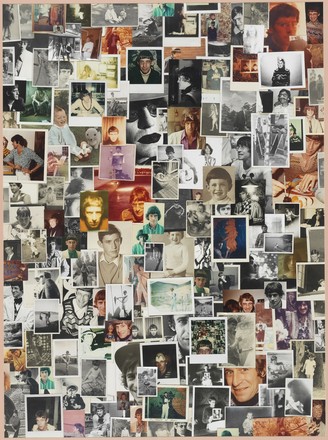Self portrait 1979
1979
Montage of photographic prints
Purchased 1989
Artist Justin O’Brien, who was Sharp’s school teacher, introduced him to the work of Vincent Van Gogh, the painter who would become his biggest artistic influence. Van Gogh’s dream of a utopian artist’s settlement was Sharp’s inspiration for the Yellow House, an art collective he co-founded in Kings Cross in 1970. Each room in the Macleay St terrace was an artwork in itself, and the Yellow House has become a celebrated piece of Sydney’s artistic history.
Luna Park
Sharp had a long
history with Sydney's iconic Luna Park. While living in London in 1973, he received an invitation to redesign the amusement
park’s face, and became one of Luna
Park’s resident artists for much of the 1970s. When
seven lives were lost in a fire in the ghost train in 1979, Sharp developed complex theories about the cause and significance of this disaster that haunted him
for the rest of his life.
Sharp cream
"I
visited the Speakeasy Club in London one evening (1967). I saw a girl I knew, Charlotte,
who was sitting at a table with two young men who didn't know. Being alone I
asked if I could join them and I was made welcome … I gathered that the young men
were musicians and as I had just written a poem which I thought would make a
good song, I mentioned this fact, and one of the musicians replied that he had
just written some music. In grand show business tradition I wrote the lyrics on
a paper serviette and gave them to him with my address … I was pleasantly
surprised when the musician, who turned out to be Eric Clapton, arrived at the
studio with a 45 r.p.m. record with "Strange Brew" on the A-side and
my song, "Tales of Brave Ulysses" on the B-side.
Soon
after I moved to a nearby studio in "The Pheasantry", Kings Road,
Chelsea, and needing someone to share with I asked my new friend if he would
care to share the space and experience. Chelsea was an exciting place to live
and Eric agreed …Eric asked me to design the cover for "Disraeli
Gears". I loved record cover art and was very happy to do it … I was using
fluorescent paints at the time. It was the height of psychedelia.
Some of
the ingredients in the cover are made up from Victorian decorative engravings.
It was done in black and white first and then painted with fluorescent colors.
I tried to capture the warm joyful liveliness of Cream's songs. I later went on
to design the cover for "Wheels Of Fire" for Cream.”
Martin
Sharp quoted on http://www.milesago.com/People/martin-sharp.htm
Eternity
A recurring element in Sharp’s
work was the "Eternity" signature. The inspiration for this
was the story of Sydney man Arthur Stace, also known as "Mr
Eternity". Stace was an illiterate former soldier, criminal and
alcoholic who became a convert to Christianity in the late 1940s. From his conversion until his death in the 1960s, Stace walked the streets of
Sydney at night writing in chalk the single word "Eternity" on walls
and footpaths. Stace's identity remained unknown
until he was revealed as the writer in a newspaper article in the early 1960s.



 Back to list
Back to list